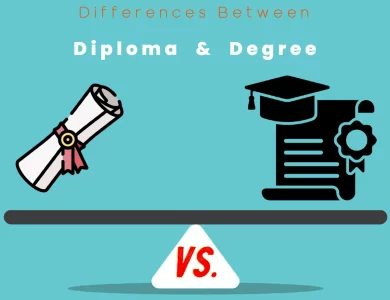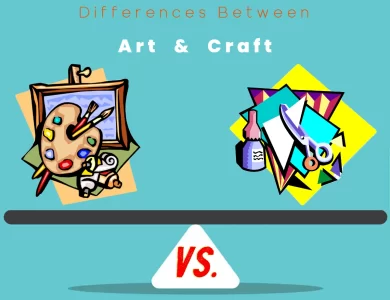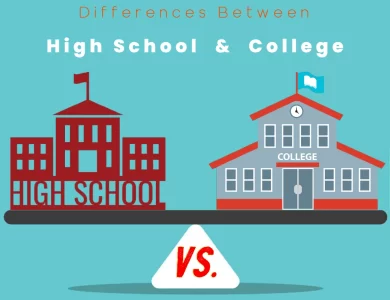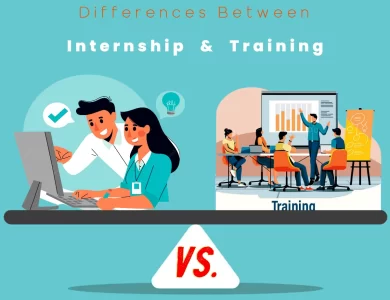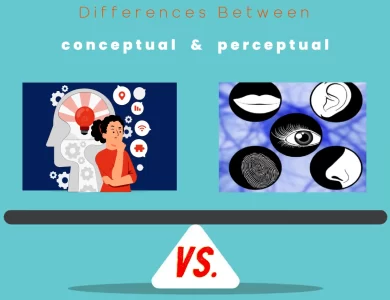Education
In this informative space, we aim to shed light on the various nuances and distinctions that exist within the realm of education. Whether you’re a student, educator, or simply curious about the intricacies of educational terminology, you’re in the right place.
Education is a vast field, encompassing a myriad of concepts, methodologies, and practices. It’s no wonder that there are often variations in terms, approaches, and other elements across different educational systems, countries, and even institutions. Our goal here is to help you navigate these differences and gain a deeper understanding of the diverse landscape of education worldwide.
To facilitate your exploration, we have organized our content into different sections, each focusing on a specific aspect of educational disparities. Let’s dive into the exciting topics we have in store for you!
-

Degree vs Diploma
In the realm of higher education, the decision to pursue a diploma or a degree is a pivotal crossroads on one's academic journey. It's a choice that can significantly influence not only the depth of your knowledge but also the trajectory of your career. The question that often looms large for prospective students is, "What are the main differences between a diploma and a degree?" Let's embark on a journey of exploration to decipher these distinctions. Diploma Programs: Diploma programs are the expressways to practical expertise in specific trades or professions. They are known for their relatively short duration, typically spanning 1 to 2 years. The curriculum in diploma programs is highly specialized, with a laser focus on hands-on, practical training. This means that students are equipped with the skills and knowledge necessary to excel in entry-level positions upon graduation. Diplomas are also renowned for their affordability, making them an attractive option for individuals concerned about the costs associated with higher education. Flexibility is another hallmark of diploma programs, often offering part-time and evening classes to accommodate students' diverse schedules. While they might require a high school diploma or its equivalent as an admission requirement, diploma credits may not always transfer to degree programs, depending on the institution and the specific program. Degree Programs: In contrast, degree programs are the comprehensive educational marathons, designed to provide a broader and more in-depth understanding of various subjects. They generally take longer to complete, typically three to four years for a bachelor's degree. Degrees encompass a mix of general education courses alongside major-specific coursework. This academic rigor fosters critical thinking, research, and a deeper theoretical understanding of the chosen field. Career opportunities associated with degrees are diverse and often extend to more high-paying professions. A wide range of industries, such as engineering, healthcare,…
-

Craft vs Art
Art and craft, two pillars of human creativity, showcase the diversity and richness of our artistic expressions. While both share a passion for creation, they stand apart in several key dimensions. Art is the realm where imagination takes flight, where aesthetics meet emotions, and where deeper meanings unfold. It transcends boundaries, often challenging conventional norms. Art is an individual's canvas, offering boundless space for creativity, originality, and pushing the boundaries of what's possible. It can provoke, inspire, and connect on profound emotional levels. The value of art often lies in its ability to touch our souls and spark meaningful discussions. Craft, on the other hand, is an art form rooted in tradition, precision, and functionality. It embodies the beauty of skill and adherence to established techniques. Craftsmen create tangible items with both aesthetic appeal and practical purpose. Whether it's pottery, textiles, or jewelry, craft aims for consistency and utility. It symbolizes cultural heritage and often reflects the identity of specific communities. In our exploration of the differences between art and craft, we'll delve into their purposes, their historical and contemporary significance, and the unique roles they play in our lives. Whether you're an artist, a craftsman, or simply an enthusiast, join us on this journey through the captivating realms of art and craft.
-

College vs High School
The transition from high school to college marks a significant turning point in the lives of students, characterized by newfound independence, academic challenges, and personal growth. Understanding the key differences between these two educational stages is paramount for making informed decisions about one's academic journey. In high school, students follow a predetermined curriculum, often with limited elective choices. High school provides a structured environment with smaller class sizes, offering more personal interaction with teachers. Grading involves continuous assessment, with opportunities for grade improvement, and the emphasis is on building a strong foundational education. Conversely, college offers greater academic freedom, allowing students to choose courses aligned with their interests and majors. Class sizes vary, and students interact more independently with professors. College grading typically involves major assessments, and there are fewer chances to improve grades. Moreover, the shift from high school to college necessitates enhanced personal responsibility, self-discipline, and effective time management. Financial considerations also come into play, with college expenses often requiring financial aid and part-time jobs. These differences encompass various aspects of academic, social, and personal development, making the transition from high school to college an exciting and transformative journey for students as they embrace a world of opportunities and possibilities.
-

School vs Faculty
Are you pondering the disparities between faculty and school, trying to decipher their distinct roles in the educational landscape? Look no further! In this informative guide, we unravel the primary differences between these two entities that often share semantics but have crucial disparities in terms of scope, structure, and educational objectives. Faculty typically represent specialized academic divisions within higher education institutions. Their core focus revolves around in-depth, research-intensive programs, and they cater primarily to undergraduate, graduate, and postgraduate levels of education. If you're a passionate undergraduate, a graduate considering further studies, or someone just keen to explore the educational intricacies, we'll shed light on the semantics and entities of these educational pillars. Schools, on the other hand, embrace a broader spectrum of educational levels, spanning from early childhood to post-secondary education. Their curriculum is designed for a well-rounded education that covers a wide range of subjects. So, whether you're a student navigating academic choices, a parent guiding your child, or simply a curious explorer of the education realm, this guide is your compass. Join us on this journey as we explore the semantics, entities, and nuances of the education system. The choice between faculty and school lies ahead, and this guide is your map to informed decisions about your educational path. The adventure starts here!
-

Department vs Faculty
In the intricate tapestry of higher education, two essential components shape the academic landscape: Faculty and Department. These terms often appear interchangeable at first glance, but they serve unique roles and functions within the academic ecosystem. To make informed decisions about your academic path, it's crucial to understand the distinctions between these entities. Faculty, encompassing multiple academic departments, offers a holistic perspective on education and research. It encourages interdisciplinary collaboration and is led by a Dean, a high-level academic administrator. Faculties promote cross-disciplinary initiatives, making them an excellent choice for students exploring various academic interests. Departments, on the other hand, are specialized units dedicated to specific academic disciplines or fields. Led by a Department Chair, they prioritize in-depth knowledge and expertise within their particular area. If you have a clear major in mind and a passion for advancing knowledge in a specific discipline, aligning with a Department may be the way to go. Understanding the differences between Faculty and Department is vital for students selecting a major and faculty members considering their career paths. Whether your journey leads you to the interdisciplinary horizon of a Faculty or the specialized realm of a Department, these distinctions will guide your academic endeavors.
-

Metacognition vs Cognition
Cognition and metacognition, two intricate processes that govern the way we think and learn, often intertwine in our daily lives. While they share a common thread of influencing our cognitive abilities, they are distinct in their nature and functions. Cognition, the powerhouse of mental activities, encompasses a vast spectrum of processes—perception, memory, reasoning, language comprehension, and problem-solving. It's the force that drives us when we read, solve puzzles, or make decisions. Cognition acts as the cornerstone of understanding the world around us, laying the foundation for acquiring knowledge and adapting to an ever-changing environment. Metacognition, on the other hand, is the introspective guide to our cognitive processes. It's the awareness and control center, allowing us to think about our thinking. Metacognition enables us to monitor, regulate, and optimize our thought processes. Think of it as the voice inside your head that assesses your understanding, sets goals, and fine-tunes your cognitive strategies. In this journey of exploration, we will delve into the distinctive contrasts between cognition and metacognition, shedding light on their roles, development, real-world applications, and how balancing these two mental forces can empower us in our quest for knowledge and personal growth. Join us in uncovering the captivating intricacies of the mind's inner workings.
-

Vygotsky vs Piaget
In the realm of child development and education, two prominent figures, Jean Piaget and Lev Vygotsky, have illuminated the path to understanding how children grow, learn, and construct knowledge. While both theorists share a common goal—to unravel the mysteries of cognitive development—their approaches and viewpoints diverge in significant ways. Piaget's Theory: Jean Piaget, a Swiss psychologist, is renowned for his constructivist theory of cognitive development. He posited that children actively construct their understanding of the world through a series of distinct, fixed, and sequential stages. In Piaget's world, development unfolds through individual exploration, with each stage building upon the cognitive accomplishments of the previous one. His theory underscores the universal and invariant nature of cognitive development, suggesting that all children follow the same developmental sequence. Vygotsky's Theory: Lev Vygotsky, a Soviet psychologist, presented a contrasting perspective rooted in sociocultural theory. Vygotsky's theory rejects the notion of fixed developmental stages. Instead, it centers on the Zone of Proximal Development (ZPD), emphasizing the role of social interaction and cultural context in cognitive growth. According to Vygotsky, learning and development are interwoven, and children thrive when they receive guidance and support from more knowledgeable individuals. His theory acknowledges the influence of culture, language, and social collaboration in shaping cognition. This blog will delve into these disparities, exploring how Piaget and Vygotsky differ in their views on language development, the role of play, assessment methods, and implications for education. By the end of our journey, you'll gain a comprehensive understanding of the rich tapestry of theories that underpin our comprehension of child development and education.
-

Training vs Orientation
When it comes to welcoming new employees into your organization, two crucial processes play a significant role in setting them up for success: orientation and training. While these terms are often used interchangeably, they serve distinct purposes and have unique characteristics. Orientation is the initial step in the onboarding process for new employees. Its primary purpose is to acquaint them with the organization's culture, policies, procedures, and the work environment. Think of it as the warm welcome you receive when you step into a new place; it's all about getting you comfortable and familiar with your surroundings. On the other hand, training goes beyond orientation and dives deeper into the specific skills and knowledge required for a particular role. It equips employees with the tools and competencies they need to perform their job effectively. Training is like the specialized training a soldier undergoes to prepare for their unique tasks on the battlefield. In this comprehensive guide, we'll explore the key differences between orientation and training, shedding light on their goals, content, duration, and outcomes. Whether you're a seasoned HR professional or a new hire trying to grasp the nuances of your onboarding journey, this article will provide you with valuable insights.
-

Training vs Internship
When it comes to shaping a successful career, understanding the disparities between an internship and training is pivotal. These two avenues offer unique opportunities for learning and skill development, each with its distinct characteristics and benefits. An internship is a practical learning experience that immerses individuals in real-world work environments. It's an excellent choice for students or recent graduates looking to bridge the gap between academic knowledge and practical application. Internships can vary in duration, often spanning from a few weeks to several months. They offer a chance to cultivate soft skills like communication and problem-solving, build professional networks, and gain valuable exposure to a specific industry. However, it's essential to note that internships can be paid or unpaid, with the compensation structure varying across organizations and regions. Training, on the other hand, is a structured educational program designed to impart specific knowledge and skills. It's suitable for individuals at various stages of their careers, from professionals seeking to upskill to career changers looking to acquire new qualifications. Training programs are typically shorter in duration compared to internships, ranging from a few days to several weeks. They focus on skill mastery and often lead to certifications, making participants more competitive in their respective fields. Unlike internships, training programs are usually fee-based, requiring participants to pay for their enrollment. In summary, the choice between an internship and training hinges on your career goals, financial situation, and preferred learning style. Internships emphasize real-world experience and networking, while training programs prioritize skill enhancement and certification. By understanding these key distinctions, you can embark on a path that aligns with your professional aspirations and sets you on the trajectory to success.
-

Perceptual vs Conceptual
In the intricate tapestry of human cognition, two distinct thinking styles weave their threads: conceptual and perceptual thinking. These cognitive modes, while fundamentally different, coexist harmoniously, shaping our understanding of the world and guiding our actions. Conceptual thinking, like an architect designing the blueprints of a skyscraper, deals with abstract ideas, principles, and intellectual concepts. It involves dissecting complex notions, forming generalizations, and drawing connections between ideas that transcend sensory details. Conceptual thinking thrives in the realm of philosophy, theoretical science, and abstract problem-solving. It shapes the language we use to discuss profound topics, the thought processes behind intricate analyses, and the foundations of our knowledge structures. On the other hand, perceptual thinking is the swift and intuitive responder to the tangible world around us. It processes real-time sensory information, guides our actions in the physical environment, and responds rapidly to sensory cues. Perceptual thinking excels in everyday scenarios where quick decision-making is crucial, such as driving a car, catching a ball, or responding to an emergency. It's the mode of thinking that allows us to interact with the world in a sensory-rich way, appreciating the immediate experiences that unfold before us. While these thinking styles have their unique strengths and applications, they often collaborate, enhancing our ability to navigate the intricacies of existence. Join us on a journey to explore the nuanced Differences Between Conceptual vs Perceptual thinking, and how they shape our world, our language, and our understanding of ourselves.
